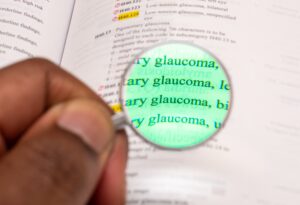Focusing on Your Eye Health – Glaucoma
Sometimes called the “silent thief of sight,” Glaucoma is an eye disease that slowly causes damage to the eye and can cause irreparable harm and possible vision loss.
Your eye has aqueous humor fluid that usually flows out of your eye. If this flow is blocked or your eye produces too much fluid, the liquid can build up. The pressure of this liquid on your eye (known as intraocular pressure (IOP)) can cause gradual damage to the optic nerve.
Types of Glaucoma
Open-angle Glaucoma – is when the drain structure in your eye looks fine, but fluid doesn’t flow out as it should.
Angle-closure Glaucoma – is when your eye doesn’t drain like it should because the drain space between the iris and cornea becomes too narrow, which can cause a sudden buildup of pressure in your eye.
Secondary Glaucoma – is when another condition, like cataracts or diabetes, causes added pressure in your eye.
Symptoms of Glaucoma
Glaucoma doesn’t usually have symptoms, so half of the people with Glaucoma don’t even know they have it. The main sign is typically a loss of side or peripheral vision.
Symptoms of angle-closure Glaucoma usually come on faster and are more prominent. Damage can happen quickly. If you have any of these symptoms, get medical care right away:
- Seeing halos around lights
- Vision loss
- Redness in your eye
- An eye that looks hazy (particularly in infants)
- Upset stomach or vomiting
- Eye pain
Who is at Risk for Glaucoma?
Everyone has the potential to have Glaucoma. That is why it is essential to have your eyes checked regularly because early detection and treatment are the only way to prevent vision impairment and blindness. There are a few groups that are at a higher risk:
- People over the age of 40
- Family history of Glaucoma
- People of African, Hispanic, Latino, and Asian descent
- People who have:
- Diabetes
- Myopia (nearsightedness)
- Regular, long-term steroid/cortisone use
- Previous eye injury
- Excessively high or low blood pressure
- Thin central corneas
It is important to take care of your eyes and have them examined. For adults with no vision problems, the American Academy of Ophthalmology recommends a complete exam at age 40. If you are 60 or older, check your eyes every year or two. You may need to have more frequent exams if you wear glasses/contacts or have a family history of eye disease.
Talk with your doctor about your risk for Glaucoma, and ask how often you need to get checked. Even if you feel you have perfect vision, an annual eye exam can be one of the best things you do!
Ronald Miller, MD
Ophthalmology
DRH Health – Miller Eye Care
